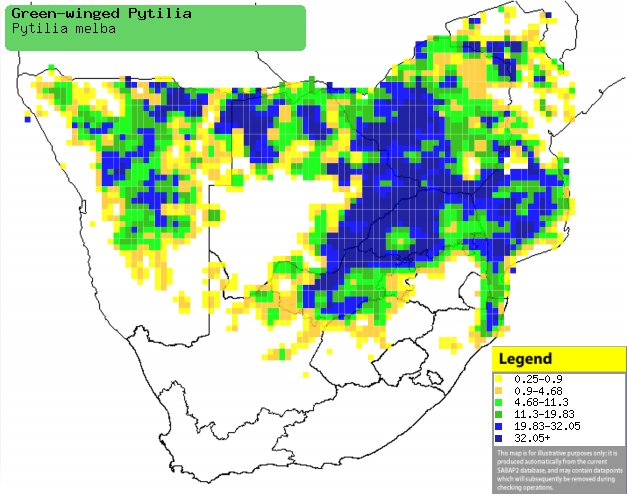|
Pytilia melba (Green-winged pytilia, Melba finch)
Gewone melba [Afrikaans]; Matemate (generic term
for pytilias) [Kwangali]; Xindzingiri bhanga (also applied to Common
waxbill and Violet-eared waxbill) [Tsonga]; Melba-astrild [Dutch];
Beaumarquet melba [French]; Buntastrild [German];
Maracachão-d'asa-verde [Portuguese]
Life
> Eukaryotes
>
Opisthokonta
> Metazoa
(animals) > Bilateria > Deuterostomia >
Chordata > Craniata > Vertebrata (vertebrates) > Gnathostomata (jawed
vertebrates) > Teleostomi (teleost fish) > Osteichthyes (bony fish) > Class:
Sarcopterygii (lobe-finned fish) > Stegocephalia (terrestrial vertebrates) >
Tetrapoda (four-legged vertebrates) > Reptiliomorpha > Amniota >
Reptilia
(reptiles) > Romeriida > Diapsida > Archosauromorpha > Archosauria >
Dinosauria (dinosaurs) > Saurischia > Theropoda (bipedal predatory
dinosaurs) > Coelurosauria > Maniraptora >Aves (birds) >
Order: Passeriformes
> Family: Estrildidae
Distribution and habitat
Occurs across much of sub-Saharan Africa excluding the
lowland forest of the West African coast, from Senegal to southern Sudan and
Somalia south to Zambia, Angola, Malawi and southern Africa. Here it is common
from Mozambique and northern and eastern South Africa to Zimbabwe, Botswana
(excluding the arid Kalahari) and northern Namibia. It generally prefers
thickets and rank clumps of grass in dry woodland, especially with Acacia
trees, while in more arid areas it favours edges of drainage lines and riverine
woodland, since it is dependent on surface water being available.
|
 |
|
Distribution of Green-winged pytilia in southern
Africa, based on statistical smoothing of the records from first SA Bird
Atlas Project (©
Animal Demography unit, University of
Cape Town; smoothing by Birgit Erni and Francesca Little). Colours range
from dark blue (most common) through to yellow (least common).
See here for the latest distribution
from the SABAP2. |
Predators and parasites
It is sometimes heavily parasitised by the tick Hyalomma
margarinatum.
Food
It mainly eats grass seeds supplemented with arthropods,
doing most of its foraging on the ground, especially in clearings or on roads. The following food items have been recorded
in its diet:
- Seeds
- grass
- Panicum maximum (Guinea grass)
- Melinis repens (Natal red top)
- Setaria verticillata (Bur bristle grass)
- Urochloa mosambicensis (Common urochloa)
- Alternanthera pungens (Khakiweed)
- Arthropods
Breeding
- The nest is a thin-walled, untidy ball-shaped structure with a side
entrance, made of curled dry grass inflorescences so that the soft ends form
the interior, which is lined with feathers or plant down. It is typically
placed in a tangled or thorny bush or tree, such as an Acacia or
mistletoe, usually 0.2-3.5 metres above ground.
- Egg-laying season is year-round, peaking from January-May.
- It lays 2-5, rarely 6 eggs, which are incubated by both sexes for about
12-14 days.
- The chicks are brooded and fed by both parents, leaving the nest after
about 18-21 days.
Threats
Not threatened.
References
-
Hockey PAR, Dean WRJ and Ryan PG 2005. Roberts
- Birds of southern Africa, VIIth ed. The Trustees of the John Voelcker
Bird Book Fund, Cape Town.
|
